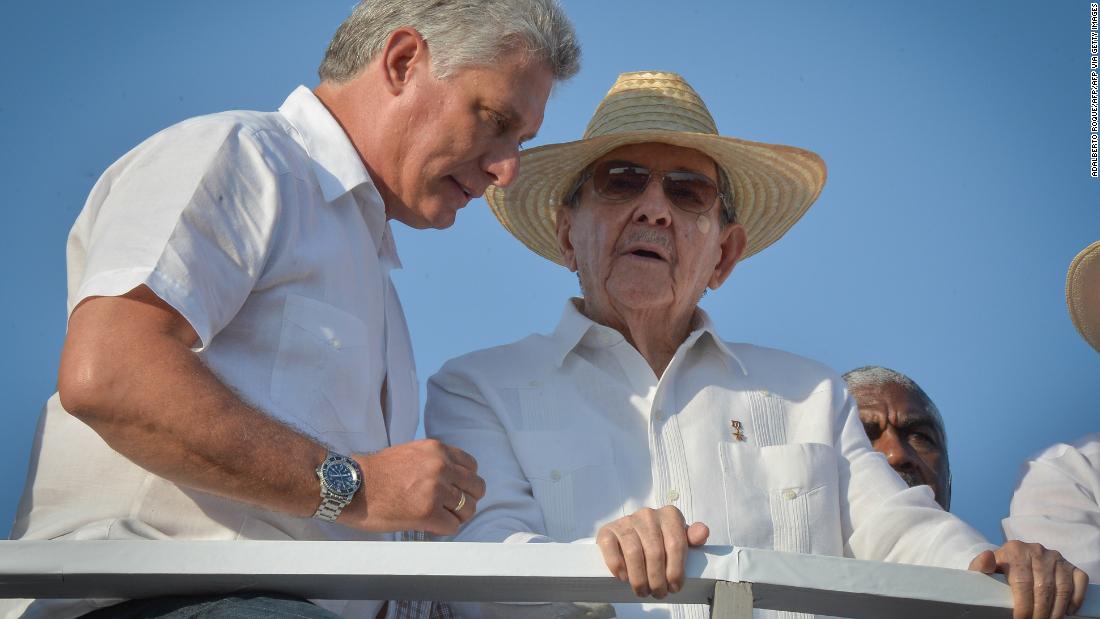
The hierarchy of the country’s Communist Party on Monday elected Cuban President Miguel Diaz-Canel to the powerful position of First Secretary, replacing Raul Castro after he announced his retirement last week.
As head of state and leader of the only political party permitted by law on the island, Diaz-Canel must chart the course for the Cuban revolution, now that the guerrilla commanders who took power in 1959 have all died or become obsolete.
“Comrade Raul will be consulted on the most important strategic decisions that will weigh most heavily on the fate of our nation. He will always be present,” Diaz-Canal said of Castro when he accepted the new position.
Born in 1960, the same year the Castro family nationalized all US property in Cuba, Diaz-Canel exudes neither Fidel’s charisma nor Raul’s authority. Despite serving in the military for three years, Diaz-Canel, unlike de Castros, is more of a pencil bureaucrat than a revolutionary in olive green uniform. That said, he will make history as the first Cuban at the helm of the government and communist party not named Castro.
And knowing how to navigate Cuba’s dysfunctional bureaucracy may prove to be a more important skill than commanding a battalion, as even many of Raul Castro’s signature proposals – transforming Mariel’s harbor into a manufacturing hub and uniting Cuba’s two currencies. – got caught up in the mire of red tape that seems to plague every endeavor of the Cuban government.
The new Cuban leader has made climbing the ranks in the communist-led system his life’s work while enjoying the continued full support of Raul Castro.
“Diaz-Canel is not the fruit of improvisation, but a thoughtful selection of a young revolutionary with the conditions to be promoted to higher office,” Castro said Friday in his speech at the Congress of the Communist Party, which was convened to the replacing the aging revolutionary.
Castro’s legacy
Since Diaz-Canel took over the Cuban presidency in 2018, he has put forward the image of a younger, more dynamic leader – someone who posts on social media and reads to government meetings from a tablet. However, his policies were as conservative if not more so than Raul Castro’s. It is a strategy aimed at assuring the older generation, who still hold important political positions, that they will not undermine their revolution.
He will need that political backing to address widespread discontent over a collapsing economy, heightened US sanctions, and increasingly tech-savvy dissident groups against the government.
Diaz-Called addressed opposition activists who he called “mercenary dick” and warned that “the patience of the people has limits.”
Some critics of the Cuban government say the transition is really a smokescreen.
“The Castro regime is trying to fool the international community by saying, ‘Oh, now the Castros are no longer in power, now a new man is in control and he is really going the country in a different way. BS! ”said Rep. Maria Elvira Salazar (R-FL), a Cuban-US congressman who won her seat in 2020 and pledged tougher sanctions against Cuba.
“The Castros are still in power,” she said.
Even if none of their family members hold leadership positions, there is no doubt that the Castros will continue to wield great influence as long as the communist-led government and the powerful army they have built remain intact.
On Monday, General Luis Alberto Rodríguez López-Calleja, son-in-law of Raul Castro, who heads a sprawling military company that controls state hotels, marinas and infrastructure projects, was first appointed to the Politburo, the executive branch. Committee of the Cuban Communist Party.
Retirement years in the making
Raul Castro has said for years that his retirement was in the works.
Unlike his older brother Fidel, who was head of state for 49 years and intended to remain in office until his death, Raul Castro took steps to limit Cuban presidents to two five-year terms and require them to the start of their first term.
He will be 90 in June, the same age as his older brother and mentor Fidel Castro when he died in 2016.
After a mysterious illness forced Fidel Castro out of power in 2008, he continued to write articles and comment on current events. By contrast, Raul Castro is expected to remain unobtrusive after retirement.
Since leaving the presidency in 2018, Raul Castro has made few public appearances. During the one with Miguel Diaz-Canel, he gives the floor to his successor.
He spends more time in a large, well-guarded house, in what was an upper-class neighborhood before the Cuban Revolution, in the eastern city of Santiago de Cuba, near where Fidel Castro is buried.
When CNN visited Santiago in 2020, residents of the city called the house “punto cero” or “point zero,” the same nickname given to the head of state’s residence where Fidel Castro lived in Havana during his last years.
While funeral plans for Fidel Castro were a state secret before his death, Raul Castro has already erected a grave in his name next to the grave of his wife Vilma Espín, a fellow guerrilla fighter who died in 2007, in a pantheon for the revolutionaries. who fought by their side.
Raul Castro, who rarely gave long speeches that his brother ever did, delivered an unusually long speech that lasted more than two hours on Friday.
“I will continue my struggle as another revolutionary fighter,” he said. “Ready to make my modest contribution to the end of my life.”